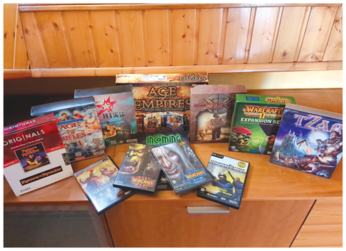Preserving legacy video games
Tutorial – Legacy Video Games
People born in the late '80s and early '90s often have a sizeable collection of old video games gathering dust at home. Systems capable of executing these are, however, becoming scarce. This article explores the options for archiving old PC games and running them on modern systems.
Ah, the late '90s! The time just before the break of the new millennium was the golden age of video games, at least for nostalgic microchip heads such as myself. This era represents a sweet spot in which computers were powerful enough to represent 3D environments, display decent graphics, and play high-quality soundtracks. Still, the video game industry had not evolved yet into the greedy machine it eventually became, inventing aggressive monetization schemes and coming up with in-game purchases, loot boxes, or intrusive digital rights management (DRM) mechanisms. Back then, the usual way of obtaining a video game for your PC or game console was to (gasp!) walk up to a store and purchase a physical copy. A PC game would take the form of a CD (or many, for large titles) which contained all the required data to install the software and play. No Internet connection was required.
I am the sort of person who keeps old stuff around forever and does not toss it into the trash bin so long as it is in working order. Therefore, I have a meaningful collection of PC games in a vault (Figure 1). While reorganizing my storage space, it occurred to me that many of these games aren't easily playable on modern computers – the ones I can realistically obtain – despite being in an excellent state of preservation. This thought immediately set me on a quest to find out how to enjoy these gems from the golden age and how to preserve them for the future (for more on why, see the "Why Make the Effort" box).
 Figure 1: A collection of PC video games from the late 1990s and early 2000s. Many of these titles are not available in retail form anymore due to licensing and trademark issues.
Figure 1: A collection of PC video games from the late 1990s and early 2000s. Many of these titles are not available in retail form anymore due to licensing and trademark issues.
[...]
Buy this article as PDF
(incl. VAT)
Buy Linux Magazine
Subscribe to our Linux Newsletters
Find Linux and Open Source Jobs
Subscribe to our ADMIN Newsletters
Support Our Work
Linux Magazine content is made possible with support from readers like you. Please consider contributing when you’ve found an article to be beneficial.

News
-
Two New Distros Adopt Enlightenment
MX Moksha and AV Linux 25 join ranks with Bodhi Linux and embrace the Enlightenment desktop.
-
Solus Linux 4.8 Features Removes Python 2
Solus Linux 4.8 has been released with the latest Linux kernel, updated desktops, and a key removal.
-
Zorin OS 18 Hits over a Million Downloads
If you doubt Linux isn't gaining popularity, you only have to look at Zorin OS's download numbers.
-
TUXEDO Computers Scraps Snapdragon X1E-Based Laptop
Due to issues with a Snapdragon CPU, TUXEDO Computers has cancelled its plans to release a laptop based on this elite hardware.
-
Debian Unleashes Debian Libre Live
Debian Libre Live keeps your machine free of proprietary software.
-
Valve Announces Pending Release of Steam Machine
Shout it to the heavens: Steam Machine, powered by Linux, is set to arrive in 2026.
-
Happy Birthday, ADMIN Magazine!
ADMIN is celebrating its 15th anniversary with issue #90.
-
Another Linux Malware Discovered
Russian hackers use Hyper-V to hide malware within Linux virtual machines.
-
TUXEDO Computers Announces a New InfinityBook
TUXEDO Computers is at it again with a new InfinityBook that will meet your professional and gaming needs.
-
SUSE Dives into the Agentic AI Pool
SUSE becomes the first open source company to adopt agentic AI with SUSE Enterprise Linux 16.

